Tourism in Egypt
| Life in Egypt |
|---|
 |
| Culture |
| Demography |
| Politics |
| Wildlife |
Tourism is one of the leading sources of income, crucial to Egypt's economy. At its peak in 2010 the sector employed about 12% of Egypt's workforce[1] serving approximately 14.7 million visitors Egypt, and providing revenues of nearly $12.5 billion.[2] as well as contributing more than 11% of GDP and 14.4% of foreign currency revenues.[3]
History

The number of tourists in Egypt stood at 0.1 million in 1951. Tourism as an important sector of the economy picked up pace from 1975 onwards, as Egypt eases visa restrictions for almost all European and North American countries and established embassies in new countries like Austria, Netherlands, Denmark and Finland. In 1976, tourism was a focal point of the Five Year Plan of the Government, where 12% of the budget was allocated to upgrading state-owned hotels, establishing a loan fund for private hotels, and upgrading infrastructure (including road, rail and air connectivity) for major tourist centres along the coastal areas. In 1979, tourism experts and advisors, were brought in from Turkey and several new colleges were established with Turkish help between 1979 and 1981, to teach diploma courses in hospitality and tourism management. The tourist inflow increased to 1.8 million in 1981 and then to 5.5 million in 2000. Tourism reached a pinnacle in 2010 by reaching 14.7 million visitors.[2][4] Revenues from tourism also reached a high point at $12.5 billion in 2010.[2] Since then the number of tourists have significantly declined (down to 9.5 million in 2013) and revenue down to $5.9 billion due to security threats and civil unrest.[2]
Significant security threats have had an ongoing effect on the industry over the past twenty years. Fifty-eight foreign tourists were killed in the 1997 Luxor massacre. The industry was also affected by the September 11, 2001 attacks in the eastern United States, the 2004 Sinai bombings, April 2005 Cairo terrorist attacks, the July 23, 2005 Sharm el-Sheikh attacks, and the 2006 Dahab bombings. Militants have typically been motivated by a combination of Qutbism and opposition to the Mubarak government, therefore attacking foreigners who are generally non-Muslims while diminishing tourist industry income was seen as serving both agendas.
Impact of revolutions on tourism
-edit2.jpg)
The 2011 Egyptian revolution that included attacks on foreign journalists such as British journalist Natasha Smith [5] and South African Lara Logan in Cairo’s Tahrir Midan (Liberation Square), along with the series of 2012–13 Egyptian protests, have negatively affected tourism. The new regime has worked hard to create stability and the Red Sea resorts in particular have had increasing tourist numbers.[6]
During the Egyptian Revolution of 2011, the number of visitors plummeted by over 37% that year falling from 14 million in 2010 to 9 million by the end of 2011. This has impacted a diverse range of businesses directly or indirectly dependent on tourism, from travel accommodation and tourist attractions to car rental and air transportation, as well as health and wellness industries. Tour operators offering heavy discounts to encourage tourists back have been somewhat successful at the Red Sea resorts where prices remain lower compared to 2011.[7]
In the first half of 2014 the number of tourists further declined by 25% as compared with the same period of 2013, while revenues shrank by 25% as well.[3][8][9]
In 2013, Egypt ranked 85th as the world's best country in terms of tourism and traveling, falling ten places from its ranking of 75 in 2011. However it regained some ground in the 2015 rankings being rated 83rd overall.[10][11]
| Year | Total number of tourists, million |
Total number of nights, million |
Total revenue, billion USD |
|---|---|---|---|
| 2010 | 14.7 | 147.4 | 12.5 |
| 2011 | 9.8 | 114.2 | 8.7 |
| 2012 | 11.5 | 137.8 | 10.0 |
| 2013 | 9.5 | 94.4 | 5.9 |
Major attractions

Major tourist destinations include the millennia-old monuments in the Nile Valley. Principal among them are the Pyramids and Great Sphinx at Giza, the Abu Simbel temples south of Aswan and the Karnak Temple Complex and Valley of the Kings near Luxor. Attractions in Cairo include the Cairo Museum and the Mosque of Muhammad Ali Pasha. The coast of the Sinai Peninsula has well-visited seaside resorts.[12]

- Giza, 20 km southwest of Cairo, has several remains from the 26th century BC such as temples and monuments to pharaohs including the Great Sphinx, and the Great Pyramids of Giza.
- Saqqara, 30 km south of Cairo is a vast, ancient burial ground which served as the necropolis for the Ancient Egyptian capital of Memphis. It features numerous pyramids, including the world's oldest standing step pyramid, as well as a number of mastabas.
- Luxor, about 500 km south of Cairo, is the site of the ancient city of Thebes. It includes the ruins of the temple complexes at Karnak and Luxor, which stand within the modern city. On the opposite side of the Nile River lie the monuments, temples and tombs on the West Bank Necropolis, which include the Valley of the Kings and Valley of the Queens.
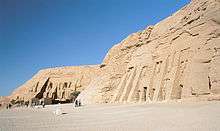
- Abu Simbel, about 850 km south of Cairo (near the Sudanese border) is an archaeological site comprising two massive rock temples originally carved out of a mountainside during the reign of Pharaoh Ramesses II (13th century BC). The complex was relocated in its entirety in the 1960s to avoid being submerged during the creation of Lake Nasser. They are now situated on an artificial hill made from a domed structure high above the Aswan High Dam reservoir.
- Alexandria is a main summer resort, due to its beaches, ancient history and Museums, especially the Bibliotheca Alexandrina, a modern project based on reviving the ancient Library of Alexandria.
- Sinai Peninsula- Sinai has the beach resorts of Sharm el-Sheikh, Dahab, Nuweiba and Taba as well as locations mentioned in the Bible such as Mount Sinai ("Jabal Musa"). Saint Catherine's Monastery may be the oldest working Christian monastery in the world.
- Ain Sukhna, about 110 km east of Cairo has a number of beach resorts.
- Assiut:in south of Egypt has historic buildings from the time of the pharaohs and ancient mosques.
Ancient Egypt
The civilization of Ancient Egypt left many monuments and temples that have become attractions for modern-day visitors to Egypt. These include:
Pyramids: there are more than 70 pyramids along the Nile, with the three pyramids of Giza being the best-known. The Sphinx, a lion-bodied guard, stands beside pyramids in Giza. The pyramids were built more than 4,000 years ago in the eras of Kings Cheops, Kefren and Mykerinos. These three kings' bodies were buried within the pyramids. The pyramid of Cheops is the largest at 145 metres in height, and is referred to as the Great Pyramid.
Saqqara Complex: The vast necropolis of Saqqara including Memphis is located 24 kilometers south of central Cairo. Memphis was founded in about 3000 BC by Menes, along with 11 other pyramids. Memphis was the administrative capital of ancient Egypt. Saqqara has Zoser's funerary complex, Mereruka's tomb and the Serapeum, a large limestone structure housing a collection of mummified Apis bulls in gargantuan granite coffins of various kings such as Teti.
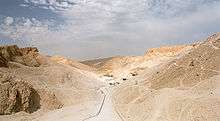
Valley of the Kings in Thebes: Due to theft from tombs within pyramids, 26 pharaohs of the eighteenth to twentieth Dynasties including Tutankhamun, Ramses the Great and Tuthmosis III had their tombs carved into the rock of the Valley of Kings. There are further tombs in the Valley of the Queens.
Nile cruises
Cruises are offered along the Nile ranging from short tours between Luxor and Aswan to longer cruises that include the northern town of Dendera.
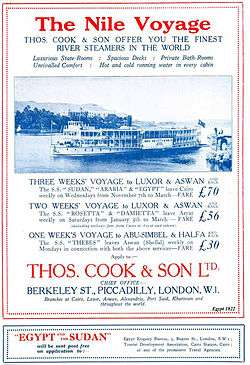
Many cruises are aboard a larger vessel that functions as a floating hotel. Other Nile trips can be on a felucca, a traditional sailboat, on which overnight journeys may require passengers to sleep in the open air on deck and the sailors to double as cooks.
Between October and mid April the daytime temperatures are cooler and the Nile's locks are open. From around the middle of April locks on the river are closed in order to manage water levels, requiring passengers to disembark on one side of the lock and transfer to another boat on the other side.
Transportation
Passports and visas are required of foreign visitors except natives of several Middle Eastern countries. Travellers native to most of Africa must have proof of cholera and yellow fever vaccination.[12]
Airports
There are nine international airports in Egypt that serve all of the county’s major cities including Cairo International Airport and Taba International Airport.[13]
Cairo International Airport is the main gateway to Egypt and is located about 15 miles northeast of the city in northern Egypt. Cairo’s three terminals receive flights from all major world cities including those in North America, Europe, Asia and Africa. You can reach central Cairo by bus, while numerous taxis also run to the city and its hotels. Limousines are also available.
Located in central Egypt, Luxor International Airport serves the Nile Valley and acts as a gateway to tourist destinations of the region. It has connections from the UK, Germany, Russia, France, Italy, and Turkey. Two terminals serve international and domestic flights, with a number of Egyptian carriers including Air Cairo and Egypt Air operating from the airport. The airport is located close to the city centre and taxis, limos and regular buses are available for transfers into the city.
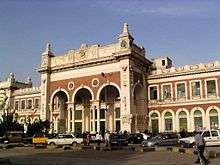
Railways
Egyptian Railways is the backbone of passenger transportation in Egypt, with 800 million passenger miles annually.[14]
Air-conditioned passenger trains usually have 1st and 2nd class service, while non-airconditioned trains will have 2nd and 3rd class. Most of the network connects the densely populated area of the Nile delta with Cairo and Alexandria as hubs.
The Alexandria-Cairo-Luxor-Aswan link is served daily in both directions by air-conditioned sleeper trains of Abela Egypt. This service is especially attractive to tourists who can spend the night on the train as it covers the stretch between Cairo and Luxor. A luxury express train also connects Cairo with Marsa Matruh towards the Libyan border.
Egyptian currency
The currency in Egypt is the Egyptian pound E£ or ج.م – can also be abbreviated as EGP and sometimes, LE or L.E. (which stands for livre égyptienne, French for "Egyptian pound"). The 1/100th unit of EGP is the Piastre. The approximate official exchange rate for $1 USD is E£17.97 EGP as of December 2016. The Central Bank of Egypt controls the circulation of currency. As of May 2009, the currency notes in circulation have a denomination of EGP 200, 100, 50, 20, 5, 1 and Piastres 50, 25.[15]
There is no limit on the amount of currency which the visitors may bring to Egypt, however, they must declare the currency and amount upon arrival and departure with bank receipts. There may be restrictions on the amount of currency that can be taken outside of Egypt so it is best to check with your hotel or a local bank to confirm the amount, but generally it should not exceed E£5,000.[16][17]
Climate
Peak tourist season in Egypt runs from mid October to May, during winter and spring. From May until October daytime temperatures are relatively high, especially in Luxor and the southern parts of the country.
Egypt is one of the hottest and sunniest countries in the world. With the exception of a strip along the Mediterranean coast, Egypt has a desert climate, being entirely within the Sahara. The Mediterranean coastal strip has an average annual rainfall of 100–200 mm. In central and southern Egypt several years may pass without any significant rain.
Winters are generally warm in the south of Egypt, but temperatures fall abruptly at night, especially in the desert. In summer southern Egypt is very hot with low air humidity.[18]
Gallery
- Major Egyptian sites
 The Egyptian Museum
The Egyptian Museum Philae
Philae The Sphinx
The Sphinx Cairo Tower
Cairo Tower- Qaitbay Citadel in Alexandria

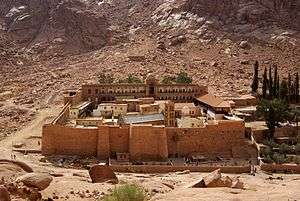
 Al-Mahmeya, a National Protected Park in Hurghada
Al-Mahmeya, a National Protected Park in Hurghada_2006.jpg) Al-Azhar Mosque, built in the Fatimid era in Cairo
Al-Azhar Mosque, built in the Fatimid era in Cairo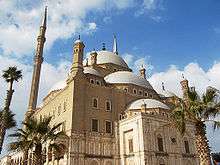 The Mosque of Mohamed Ali Pasha in Cairo
The Mosque of Mohamed Ali Pasha in Cairo The Mosque of the Imam Al-Husayn, the grandson of the Prophet Muhammed in Cairo
The Mosque of the Imam Al-Husayn, the grandson of the Prophet Muhammed in Cairo The Great Pyramids of Giza in Giza
The Great Pyramids of Giza in Giza The Luxor Temple in Luxor
The Luxor Temple in Luxor Temple of Ramesses II in Abu Simbel
Temple of Ramesses II in Abu Simbel Temple of Nefertari in Abu Simbel
Temple of Nefertari in Abu Simbel- Archangel Michael's Coptic Orthodox Church in Coptic Style in Aswan
See also
References
- ↑ "Egypt tourism numbers to fall less than feared", Reuters Africa, October 21, 2009
- 1 2 3 4 5 Adla Ragab (January 14–15, 2014). Recent development of TSA in Egypt (pdf). Fourteenth Meeting of the Committee of Statistics and Tourism Satellite Account (TSA). Retrieved 9 October 2014.
- 1 2 3 Matt Smith (11 September 2014). "Egypt tourist numbers to rise 5–10 pct in 2014 – minister". Reuters. Retrieved 9 October 2014.
- ↑ "Egypt – international tourism". Retrieved 11 October 2014.
- ↑ British Journalist Natasha Smith
- ↑ http://www.dailymail.co.uk/travel/travel_news/article-2738446/Egypt-hit-95-decline-tourism-revenue-western-travel-warnings-social-unrest-blame.html
- ↑ "Travel and Tourism in Egypt,Travel and Tourism". Retrieved 24 April 2013.
- ↑ Dalia Farouk (16 July 2014). "Egypt tourist numbers decline 20.5 pct in June year-on-year". Ahram Online. Retrieved 9 October 2014.
- ↑ Matt Smith (30 August 2014). "www.dailymail.co.uk/travel/travel_news/article-2738446/Egypt-hit-95-decline-tourism-revenue-western-travel-warnings-social-unrest-blame.html – minister". Daily Mail. Retrieved 11 September 2015.
- ↑ "Table 1: The Travel & Tourism Competitiveness Index 2013 and 2011 comparison" (PDF). Retrieved 11 October 2014.
- ↑ "Table 1: The Travel & Tourism Competitiveness Index 2015". Retrieved 11 September 2015.
- 1 2 "Egypt: Tourism, travel, and recreation". Nations Encyclopedia. Retrieved 2008-06-05.
- ↑ Aircraft Charter World: Airports in Egypt
- ↑ Egypt National Railways
- ↑ Central Bank of Egypt
- ↑ Consulate General of Egypt
- ↑ Consulate General of Egypt – Visa Application Instructions/Customs Declarations
- ↑ BBC Weather Guide
External links
| Wikivoyage has a travel guide for Egypt. |
| Wikimedia Commons has media related to Tourism in Egypt. |
- Egyptian Tourism – Official government tourism agency.
| Wikimedia Commons has media related to Tourism in Egypt. |